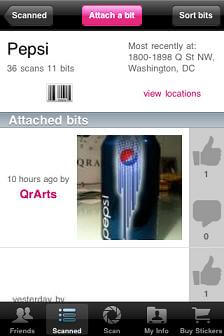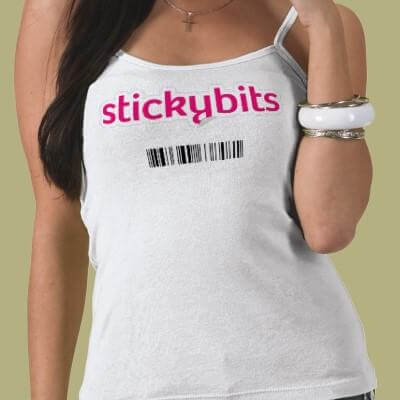
Imagine every object with a barcode suddenly gaining a Twitter feed, but with photos, and videos as well as comments and links. That, in essence, is Stickybits. The New York City based startup combines the promise of the Internet of Things with the inane addictiveness of social media. Here’s how it works. You download the free App (iPhone or Android), you scan a barcode on an item, you attach a photo, video, audio or comment, and then everyone else who’s scanned that item can see what you’ve uploaded. The attachments are called bits and when you scan an item you see all the bits every one has already attached as part of a ‘bitstream’. Users can also upvote each other’s bits so that the most relevant, or crazy, bits are shown first. Unveiled this spring at the SXSW Festival in Austin, Stickybits is gaining users rapidly as every one rushes to find ways to take advantage of this new object based social media tool. Stickybits has already teamed up with PepsiCo, and now companies can get their bits to appear first in an object’s bitstream. Check out my brief demo below followed by a video of founder Billy Chasen describing his technology. There’s a kind of gold-rush feel to Stickybits at the moment, but it’s unclear if the hype will ultimately pan out.
When someone first described Twitter to me I thought it was stupid. Why would I want everyone to know where I was and what I was thinking at the moment? Now Twitter’s one of the big social media memes on the internet. Stickybits could follow the same path. Why would I want to know what everyone is doing with their bottle of cola? No idea, but I think social media has shown us that sharing information is its own reward. We live in a commercialized society and using those industrial goods as centers for discussion has some serious potential.
Here’s a quick demo I made of what it looks like to use Stickybits on your phone. If you have your own 500 mL bottle of CocaCola Classic you can probably find the bit I made during this video.
Sharing comments about items is just one of several possible ways to use Stickybits. As founder Billy Chasen describes, you can use barcodes as links so that your friends can share one to one information about an object. Chasen also describes some other updates, like company sponsored bits. I’m not sure how I feel about corporations having first dibs on the bitstream through ‘official bits’ but I’m glad Chasen sees the importance of merging the digital world with the physical one.
We’ve been talking about the Internet of Things for a while now, but Stickybits is one of the first clear applications that’s readily accessible to anyone for free. That being said, Stickybits is sort of IoT-lite. There are some cool possible applications but some clear limitations as well. The first, and most obvious, is that Stickybits is less about a single object, and more about a group of objects. When I scan a cola bottle, I see bits about other bottles just like it, but not about my particular bottle. Geotags, social media, etc are all generalized, not specific. That’s okay for common throw-away items, but more permanent objects (cars, furniture, etc) don’t often come with barcodes. You can add a sticker and make a unique barcode for an object, but you really only get data in the bitstream that you added yourself.

Chasen talks as if these specialized one-off barcodes (via stickers or products purchased on the site) will be half of the Stickybits experience, but just judging from my own quickly formed preferences I think the commercial barcodes will dominate. As such, I think that Stickybits is destined to not just become a Twitter about objects, but a Twitter about the common ground that commercial items create. In the worst case scenario it will devolve into a commercial stream controlled by the corporate owners of products to promote their brands. In the best case scenario Stickybits will allow users to anchor their digital content into physical objects, creating a sort of half-randomized way of connecting to others through shared experiences.
If you venture into the StickyWiki (I can’t imagine what British people think of these names) you can see that Stickybits is still working through the kinks of its implementation. There are troubles navigating privacy settings, it’s hard to delete bits, and other bugs pop up here and there. Clearly it will take Chasen and his team a little while to figure out the exact shape that Stickybits will need to take. In the meantime, you may ask yourself, “should I bother exploring this thing?”
Well, I’ve been playing around with Stickybits all day now, and I’m getting addicted. There’s something vaguely exciting about exploring the everyday items around your home and seeing what everyone else has been saying about them. I ran into a really funny bit about Trident spearmint gum… You know what? Forget about it. If you’re really interested in what someone is saying about the gum I buy go download the Stickybits App and find out for yourself.
Ugh, social media, you have claimed another precious night of my life. Curse you and bless you for your splendid banality.
[image credits: Stickybits]
[source: Stickybits]



